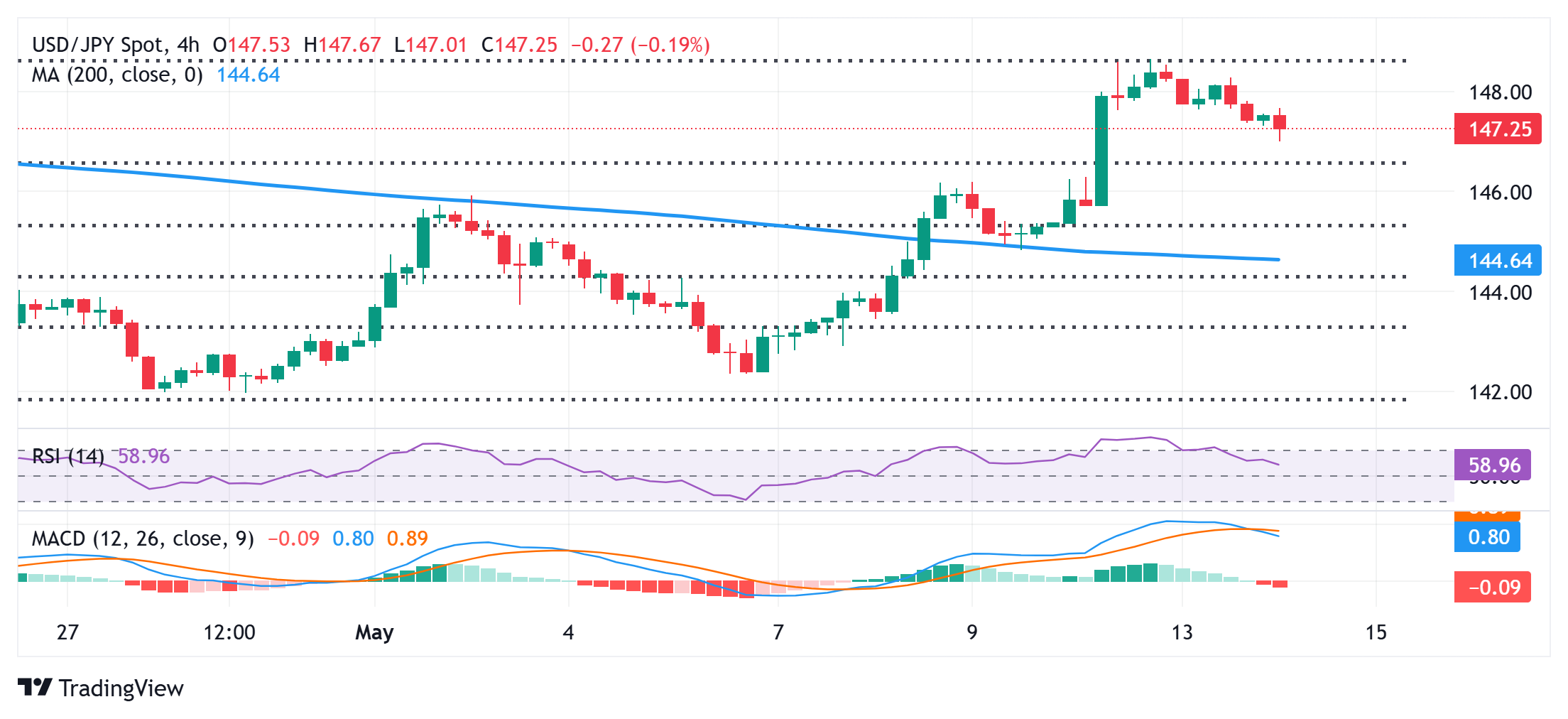Japanese Yen moves away from one-month low touched against USD on Monday
- The Japanese Yen strengthens against the USD for the second straight day on Wednesday.
- The prospects for further policy normalization by the BoJ continue to underpin the JPY.
- Softer US CPI lifts bets for two Fed rate cuts in 2025, weighing on the USD and USD/JPY.
The Japanese Yen (JPY) remains on the front foot against its American counterpart for the second straight day on Wednesday and reacts little to the mostly in-line Producer Price Index (PPI). The Bank of Japan (BoJ) Deputy Governor Shinichi Uchida's hawkish comments on Tuesday keep the door open for further policy normalization and continue to act as a tailwind for the JPY. The US Dollar (USD), on the other hand, continues to be undermined by Tuesday's softer US consumer inflation figures, which lifted bets that the Federal Reserve (Fed) will cut interest rates at least two times this year. This is seen as another factor exerting downward pressure on the USD/JPY pair.
Meanwhile, the latest optimism over a US-China tariff truce for 90 days remains supportive of the upbeat market mood. This might hold back traders from placing aggressive bullish bets around the safe-haven JPY. Nevertheless, the divergent BoJ-Fed policy expectations suggest that the path of least resistance for the lower-yielding JPY is to the upside and support prospects for a further depreciating move for the USD/JPY pair. In the absence of any relevant market-moving economic data from the US, traders will take cues from speeches by influential FOMC members. Apart from this, the broader risk sentiment could provide some impetus to the currency pair.
Japanese Yen draws some support from the divergent BoJ-Fed policy expectations
- Data released this Wednesday showed that Japan's Producer Price Index (PPI) rose 0.2% in April, and the yearly rate came in at 4%, down from 4.2% in the previous month. The Japanese Yen, however, moves little after the data and draws support from expectations for more rate hikes by the Bank of Japan.
- In fact, BoJ Deputy Governor Shinichi Uchida reiterated on Tuesday that the central bank will keep raising rates if the economy and prices improve as projected. Japan's economic growth is expected to slow to around its potential before resuming moderate growth as overseas economies recover, Uchida added further.
- On the other hand, traders pared their bets for more aggressive policy easing by the Federal Reserve amid easing recession fears. Investors, however, are still pricing in 56 basis points of Fed rate cuts this year, and the bets were reaffirmed by softer US consumer inflation figures released on Tuesday.
- The US Bureau of Labor Statistics (BLS) reported that the headline Consumer Price Index (CPI) edged lower to the 2.3% YoY rate in April from 2.4% in the previous month. Meanwhile, the core CPI, which excludes volatile food and energy prices, rose 2.8% on a yearly basis, matching consensus estimates.
- This keeps the US Dollar depressed below its highest level since April 10 touched earlier this week, and exerts some downward pressure on the USD/JPY pair. However, the US-China trade deal optimism might hold back traders from placing aggressive bullish bets around the safe-haven JPY.
- US President Donald Trump said in a Fox News interview that the relationship with China is excellent. This comes on top of positive news from the US-China tariff negotiations over the weekend, where both countries agreed to pause the trade war for 90 days and bring down reciprocal duties.
USD/JPY technical setup backs prospects for the emergence of dip-buyers

From a technical perspective, the recent breakout through the 200-period Simple Moving Average (SMA) on the 4-hour chart and positive oscillators on the daily chart favor bullish traders. Hence, any subsequent slide below the 147.00 mark might still be seen as a buying opportunity near the 146.60-146.55 area, representing the 23.6% Fibonacci retracement level of the strong recovery from the year-to-date low touched in April. A convincing break below, however, might prompt some technical selling and drag the USD/JPY pair to the 146.00 mark en route to the 145.40 region (38.2% Fibo. level) and the 145.00 psychological mark. This is closely followed by the 144.80-144.75 area, or the 200-period SMA on the 4-hour chart, which, if broken decisively, would negate the near-term positive bias.
On the flip side, the 147.65 zone now seems to act as an immediate hurdle, above which the USD/JPY pair could climb to the 148.00 round figure en route to the 148.25-148.30 region and over a one-month peak, around the 148.65 area touched on Monday. Some follow-through buying beyond the latter will be seen as a fresh trigger for bulls and lift spot prices beyond the 149.00 mark, towards the 149.65-149.70 area and eventually to the 150.00 psychological mark.
Japanese Yen FAQs
The Japanese Yen (JPY) is one of the world’s most traded currencies. Its value is broadly determined by the performance of the Japanese economy, but more specifically by the Bank of Japan’s policy, the differential between Japanese and US bond yields, or risk sentiment among traders, among other factors.
One of the Bank of Japan’s mandates is currency control, so its moves are key for the Yen. The BoJ has directly intervened in currency markets sometimes, generally to lower the value of the Yen, although it refrains from doing it often due to political concerns of its main trading partners. The BoJ ultra-loose monetary policy between 2013 and 2024 caused the Yen to depreciate against its main currency peers due to an increasing policy divergence between the Bank of Japan and other main central banks. More recently, the gradually unwinding of this ultra-loose policy has given some support to the Yen.
Over the last decade, the BoJ’s stance of sticking to ultra-loose monetary policy has led to a widening policy divergence with other central banks, particularly with the US Federal Reserve. This supported a widening of the differential between the 10-year US and Japanese bonds, which favored the US Dollar against the Japanese Yen. The BoJ decision in 2024 to gradually abandon the ultra-loose policy, coupled with interest-rate cuts in other major central banks, is narrowing this differential.
The Japanese Yen is often seen as a safe-haven investment. This means that in times of market stress, investors are more likely to put their money in the Japanese currency due to its supposed reliability and stability. Turbulent times are likely to strengthen the Yen’s value against other currencies seen as more risky to invest in.

